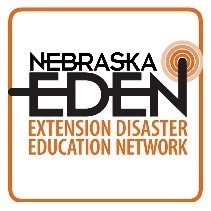
Here are the Disaster Resources that you will find helpful...
• When disaster strikes...
• Emergency preparedness for Nebraska Extension
• Disaster - Emergency - Crisis Resources...
• Nebraska Emergency Managers
• The Next Emergency Action Plan Submission Window...
• Compassionate Presence
When Disaster Strikes, Check-in Using ResponseNotes
ResponseNotes is Nebraska Extension's system for helping our Extension family "touch base" or "phone home" when disaster strikes. It's a quick-capture form you can use to let Nebraska EDEN, Nebraska Extension administration, EDEN, and our USDA liaisons know whether you've been affected, to ask for help, and to share news about what you're doing to recover or to help your constituents recover.
You and anyone in your office can submit notes using the online form, as often as you like. Don't be too concerned with spelling, grammar, polish, or lingo. What comes in through this form will be managed by the Nebraska EDEN team for you. If you have any questions, contact Soni Cochran, scochran2@unl.edu or Michael Bergland-Riese, riese@unl.edu.
ResponseNotes Form:- https://ssp.qualtrics.com/jfe/form/SV_7UR8e5VOU2JuJrU
You can find a link to the ResponseNotes by logging in to the employee resources at https://disaster.unl.edu
On behalf of the Nebraska Extension Disaster Education Network (EDEN) team, thanks for all you do!
Soni Cochran, scochran2@unl.edu
--------------------
Emergency Preparedness for Nebraska Extension
Two recent trainings are now available on the employee portal of the Disaster Education website at https://disaster.unl.edu. You’ll need to log in using your employee credentials to access the trainings on this portal. After logging in, go to the navigation bar and hover over About Us and you’ll see an option for Employee Resources:
• “Emergency Preparedness for Nebraska Extension” with Mark Robertson, UNL Campus Emergency Management Director
• “Disaster 101 with Chris Schroeder, Nebraska Emergency Management Agency
Watch for more training opportunities! We’ll announce those in Keeping Up.
Soni Cochran, scochran2@unl.edu
--------------------
Disaster – Emergency - Crisis Resources to Help Children and Families
Although everyone experiences some stress in their lives from work, bills, or life-changing events, the presence of chronic stress can compromise health and well-being. We also respond to stress in different ways. We know that as parents and educators caring for children, you want answers regarding what to do before, during, and after an emergency event, disaster, or crisis.
The Early Childhood Development team has several resources available to help families and caregivers. Visit https://child.unl.edu/disaster
Additional resources on stress, wellness, and preparedness:
• Rural Family Wellness - https://ruralwellness.unl.edu
• Ready.gov Preparedness Resources - https://www.ready.gov/
Soni Cochran, scochran2@unl.edu
--------------------
Nebraska Emergency Managers – Introduce Yourself in “Blue Skies”
Nebraska Emergency Management Agency has an interactive map to help you locate and connect with your local emergency managers. During “blue skies” is the best time to connect with your local emergency manager.
Introduce yourself and share the resources available through your office and Nebraska Extension. We aren’t first responders, but we can work with our emergency managers in support roles including sharing information and providing educational resources and programming.
Website: https://nema.maps.arcgis.com/apps/webappviewer/index.html?id=6efac613a59e46849edab8d320854b10
Soni Cochran, scochran2@unl.edu
--------------------
The Next Emergency Action Plan Submission Window Opens for Zones 5, 7, 9, 11, and Raising Nebraska
Nebraska Extension and UNL’s Office of Emergency Preparedness and Planning encourages county Extension offices and Extension units to have plans in place for disasters and emergencies. Emergency action plans (EAP) outline the procedures and information staff can use in the event of an emergency. This includes office location, contact information, sheltering-in place, evacuation procedures and more. As a reminder, this year’s EAP submission process is by zones and units.
I’m in the process of reviewing EAP’s from Zones 1, 4, 8, and 10. If you have submitted an EAP, I’ll be connecting with you yet this month. If you are in a location that is currently addressing a disaster event like the recent wildfires, please focus your efforts on being a resource for your community and colleagues. We’ll catch up on the EAPs.
Current submission window:
May 1 – June 30: Zones 5, 7, 9, 11, and Raising Nebraska. Save the Date - Creating Your EAP Office Hours for zones 5, 7, 9, and 11 and Raising Nebraska: Thursday, June 9, 10 a.m. CDT/9 a.m. MDT. A Zoom invitation will be sent separately to Zones 5, 7, 9, 11, and Raising Nebraska.
Upcoming submission window: September 1 – October 31: Zones 2, 3, and 6
Remember, EAPs are living documents. While offices/units are asked to submit them on an annual basis for our organizational records, EAPs should be updated continually as the need arises (i.e. someone retires/resigns, someone new joins the office, change of office location, etc.).
If you have any questions, please let me know. I look forward to working with you all as we continue working on these plans.
Soni Cochran, scochran2@unl.edu
--------------------
Compassionate Presence: The Role of Faith-Based Communities in Disaster Recovery
Holly Hatton-Bowers, Assistant Professor; Kara Kohel, Graduate Student in Child, Youth and Family Studies; and Michelle Krehbiel, Youth Development Specialist/Associate Professor
One way to support disaster survivors is by partnering with faith-based communities (FBCs). The role of faith and religious practice in health, resilience and recovery are sometimes overlooked, but they play an important role in making sense of difficult times and moving forward with hope. Faith leaders act as a crucial bridge for supporting community efforts and engaging survivors to address their emotional and spiritual wellness.
Places of worship, pastors and other faith leaders are important sources of support to facilitate resiliency during disasters. Faith leaders can provide a community of care and are generally viewed as integral to the community in providing trust, support, safety and hope. During a time when the future may seem bleak, faith leaders can help to restore hope, faith and meaning in life following a disaster. These types of supports can also contribute efforts in helping communities to heal, recover and thrive. Read the article Compassionate Presence: https://go.unl.edu/faith-hhb